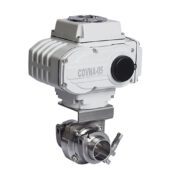
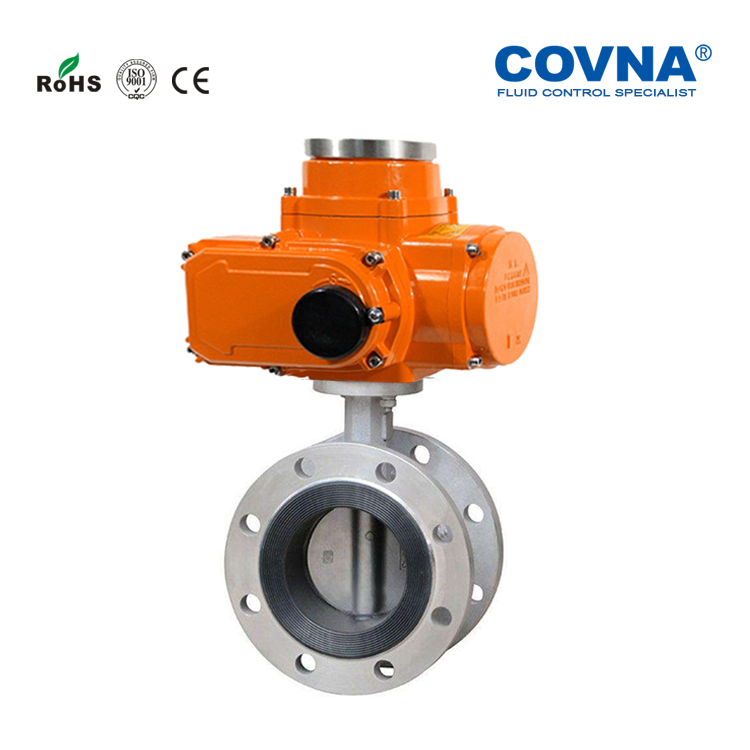






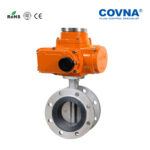
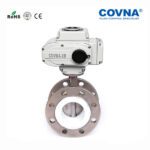
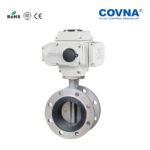



COVNA HK60-D-F Flanged Motorized Butterfly Valve
COVNA Electric actuated wafer butterfly valve with features of easy to install and easy to operate. Available in stainless steel, cast iron or carbon steel materials to fulfill your needs.
Flanged motorized butterfly valve is designed to regulate the flow of fluids in a piping system. The valve body consists of a disc that is positioned at a right angle to the flow of fluid. The disc rotates around a shaft to either block or allow the flow of fluid through the valve. The electric motorized actuator provides precise control over the valve’s position and flow rate.
Model
- Actuator Type: ON OFF Type, Modulating Type
- Body Material: Cast iron or Stainless Steel 304/316/316L
- Pressure: 10bar (Hard sealing up to 40 bar)
- Temperature Of Media: -40 to 450℃ (-40℉ to 842℉)
- Suitable Media: Water, Oil, Air, Gas, Steam, etc
- Voltage: DC-12V, 24V; AC-24V, 110V, 220V, 380V
- Connection Type: Flanged (ANSI, JIS, DIN, GB)
Technical Parameters:
Model: HK60-D
Valve Materials: Stainless steel/Cast iron/Carbon steel
Sealing Materials: EPDM/PTFE
Actuator Options: On/Off type actuator, Modulating type actuator, Explosion-proof type actuator
Power Supply: DC-12V, 24V; AC-24V, 110V, 220V, 380V
| Model | HK60D |
| Torque Range | 50Nm to 4000Nm |
| Size Range | 19mm to 102mm |
| Pressure | 10bar, 16bar (145psi, 232psi) |
| Temperature | -10℃ to 180℃ (14℉ to 356℉) |
| Voltage | DC-12V, 24V; AC-24V, 110V, 220V, 380V |
| Medium | Food, Milk, Soft Drink, Water, And Other Medium |
HK60-D-F Flanged Motorized Butterfly Valv
What Is Motorized Butterfly Valve
Motorized butterfly valve is a control valve widely used in various industrial fields. It consists of a metal “butterfly” that can rotate and completely or partially close the valve inside a pipeline, thus controlling the flow and pressure of fluid. Motorized butterfly valve usually consists of components such as a disc, valve stem, transmission components, electric motor, position indicator, and controller.
Its benefits include space saving, ease of maintenance, wide application and automation capabilities, making it an efficient, accurate and reliable control valve and is used in a wide range of industries such as the chemical industry, oil and gas, pharmaceuticals, food processing, water treatment and many more.
Benefits Of Electric Flanged Butterfly Valves:
COVNA Electric Flanged Butterfly Valves provide a reliable and efficient fluid control solution for you. Flanged butterfly valve can be customized to ANSI standard, JIS standard, DIN standard or GB standard according to your pipeline requirements. Moreover, the parts of the butterfly valve can be replaced according to your project requirements, including valve plate, seal, valve body materials, etc., to meet your high pressure, high temperature or anti-corrosion needs.
It can be used with electric actuators to easily realize remote control and realize industrial automation.
- Novel design, reasonable, unique structure, light weight, quick opening and closing
- The operating torque is small, the operation is convenient, and the labor-saving and dexterous
- It can be installed in any position, easy maintenance
- Sealing materials are resistant to aging, corrosion and long service life
- Widely used in process control occasions such as food, pharmaceuticals, cosmetics, clean steam, alcohol, beverages, biochemical industrial processes
Technical Parameters of Valve Actuator
| ON/OFF Type | Feedback: the active contact signal, passive contact signal, resistance, 4-20mA |
| Regulation Type | Input & Output signal: DC 4-20mA, DC 0-10V, DC 1-5V |
| Field operation | The Field, Remote Control Switch Regulation and MODBUS, PROFIBUS Field Bus |
| Voltage Optional | AC110-240V 380V 50/60HZ: DC12V, DC24V, Special Voltage Can be Customized |
| Protection Class | IP65, Explosion Proof Construction Are Available: EX ll BT4 |
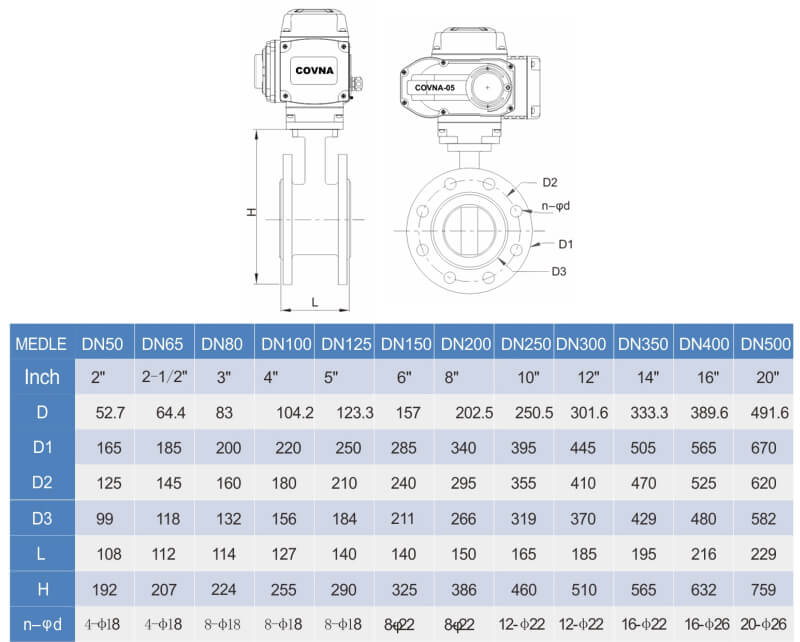
| Model | 05 | 10 | 16 | 30 | 60 | 125 | 250 | 400 |
| Torque Output | 50Nm | 100Nm | 160Nm | 300Nm | 600Nm | 1250Nm | 2500Nm | 4000Nm |
Technical Parameters of Valve Body
| Valve Body | Valve components | ||
| Nominal size | DN50-DN400 | Sealing material | PTFE, Silicone |
| Body Material | Stainless Steel | Disc Material | Stainless Steel 316 |
| End Connection | Tri-clamp | Stem Material | Stainless Steel |
| Operating Pressure | 1.0 / 1.6 MPa (10 / 16 bar) | Applicable media | Water, Air, Gas, Petroleum, Oil, Liquid |
| Structure | Midline structure A type | Design standard | GB, ASMI |


Technical Parameter of Valve Body:
| Nominal Size | DN15-DN200 | Body Material | PVC, UPV, CPVC, PVDF and PPH |
| End Connection | True Union, Double Union Thread | Structure | T Port / L Port |
| Operating Pressure | 1.0 / 1.6 MPa (10 / 16 bar) | Voltage Tolerance | ±10% |
| Suitable Media | Corrosive media, Water, Air, etc | Temperature Of Media | -5~80℃ (23℉~176℉) |
| Design standard | ISO, DIN, IDF, SMS, 3A | Orifice(mm) | 15, 20, 25, 32, 40, 50, 65, 80, 100 |

Package & Shipping:
As a professional electric ball valve manufacturer, COVNA aims to provide our customers the best quality products with the most competitive pricing, on-time delivery and full warranty service with omprehensive service from start to finish, encompassing consultation through to after sales service, full support in every respect and ensure that you are accompanied at each stage of your project.

Company Profile:
_2022_03(1).png)

Factory Profile:

Company Certificates:

Purchase Guide:
- Confirm the valve size you need. We offer this motorized butterfly valve in 19mm to 102mm
- Confirm the valve body material you need. We offer this motorized butterfly valve in stainless steel 304, ss316, ss316L
- Confirm the connection standard. We offer this food safe motorized butterfly valve in tri-clamp, thread and welded connection for your project
- Confirm the pressure and working temperature. Pressure and temperature are the important points and those may affect the cost
- Confirm the voltage you need. The right voltage could help your valve operate better
- Tell us your medium. Different medium has different features and we will help you to select the valve basic on the medium requirements
- Confirm the actuator type you need. We have On/off type, modulating type, intelligent type, explosion-proof type or IP68 type electric valve actuator for your project
- Any requirements please tell us like disc material, sealing material, or connection standard. We could help you to custom the valve you need
Technical Parameter of Actuators:

| Model | 5 | 10 | 16 | 30 | 60 | 125 | 250 | 400 |
| Torque Output | 50Nm | 100Nm | 160Nm | 300Nm | 600Nm | 1250Nm | 2500Nm | 4000Nm |
| 90°Cycle Time | 20s/60s | 15s/30s/60s | 15s/30s | 15s/30s | 30s/60s | 100s | 100s | 100s |
| Angle of Rotation | 0-90° | 0-90° | 0-90° | 0-90° | 0-90° | 0-90° | 0-90° | 0-90° |
| Working Current | 0.25A | 0.48A | 0.68A | 0.8A | 1.2A | 2A | 2A | 2.7A |
| Starting Current | 0.25A | 0.48A | 0.72A | 0.86A | 1.38A | 2.3A | 2.3A | 3A |
| Drive Motor | 10W/F | 25W/F | 30W/F | 40W/F | 90W/F | 100W/F | 120W/F | 140W/F |
| Product Weight | 3kg | 5kg | 5.5kg | 8kg | 8.5kg | 15kg | 15.5kg | 16kg |
| Voltage Option | AC 110V, AC 220V, AC 380V, DC 12V, DC 24V | |||||||
| Insulation Resistance | DC24V:100MΩ/250V; AC110/220V/380V: 100MΩ/500V | |||||||
| Withstand Voltage | DC24V:500V; AC110/220V:1500V; AC380V:1800V 1Minute | |||||||
| Protection Class | IP65 | |||||||
| Installation Angle | Any | |||||||
| Electrical Connection | G1/2 Water-proof Gable Connectors, Electric Power Wire, Signal Wire | |||||||
| Ambient Temp. | -30℃to 60℃ | |||||||
|
Control Circuit
|
A: ON/OFF type with light indicator signal feedback | |||||||
| B: ON/OFF type with passive contact signal feedback | ||||||||
| C: ON/OFF type with resistance potentiometer signal feedback | ||||||||
| D: ON/OFF type with resistance potentiometer and neutral position signal feedback | ||||||||
| E: Regulation type with servo control module | ||||||||
| F: DC24V/DC12V dirct ON/OFF type | ||||||||
| G: AC380V three-phase power supply with passive signal feedback | ||||||||
| H: AC380V three-phase power supply with resistance potentiometer signal feedback | ||||||||
| Optional Function | Over Torque protectors, dehumidify heater, stainless steel coupling & yoke | |||||||
1.Oil and Gas Industry
Pipeline Flow and Pressure Control: Used for flow and pressure control in natural gas and oil pipelines to ensure stability during transportation.
Gas and Liquid Distribution Systems: Regulates the flow of gases or liquids, ensuring precise control under various operating conditions.
Automation of Distribution Systems: Used in refineries and natural gas processing plants to automate fluid distribution and regulate the reaction processes.
2.Chemical and Petrochemical Industry
Reactor Pressure and Flow Control: Used in chemical reactors, storage tanks, and other equipment to control pressure and flow, ensuring stability in the chemical reaction process.
Flow/Pressure Regulation: Regulates the flow of liquids or gases in processes such as polymerization, refining, and distillation to ensure efficient production.
Steam Control: Regulates the flow and pressure of steam in steam generators and distribution systems.
3.Water and Wastewater Treatment
Water Flow Control: Regulates water flow and pressure in water supply and wastewater treatment systems to ensure normal operation.
Gas and Chemical Additions: Regulates the flow of chemicals or gases (such as chlorine or ammonia) added during the water treatment process.
4.HVAC (Heating, Ventilation, and Air Conditioning) Systems
Temperature Control and Airflow Regulation: Used in air conditioning systems to regulate the flow of cooling or heating fluids to maintain the desired temperature.
Pressure and Airflow Regulation: Adjusts the flow and pressure of air in ventilation, air conditioning, and humidification systems to ensure indoor comfort.
5.Food and Beverage Industry
Liquid Flow Control: Precisely controls the flow of liquids in processes such as brewing, dairy production, and beverage bottling.
Temperature and Pressure Regulation: Regulates temperature and pressure during heating, cooling, and sterilization to ensure product quality and safety.
6.Pharmaceutical Industry
Precision Flow Control: Regulates the flow of liquids and gases in pharmaceutical manufacturing processes to ensure precise control of process parameters.
Pressure Control: Adjusts pressure in cleaning and sterilization systems to ensure stable system operation.
7.HVAC Systems
Airflow and Temperature Control: Controls the flow and temperature of air to adjust environmental conditions, ensuring comfort and energy efficiency inside buildings.
8.Steel and Metallurgical Industry
Gas Flow Control: Precisely adjusts the flow of gases such as oxygen and nitrogen during smelting and heating processes to ensure stable furnace temperatures and chemical reactions.
Cooling Fluid Flow Regulation: Regulates the flow of cooling fluids in cooling systems to ensure temperature control of equipment.
9.Thermal and Power Industry
Steam and Water Flow and Pressure Control: Regulates the flow of steam and water in boiler systems, heat exchangers, and power plants to ensure efficient operation of thermal systems.
10.Mining Industry
Slurry Flow Regulation: Adjusts the flow and pressure of slurry during transportation and separation processes to ensure efficient extraction and processing of minerals.




